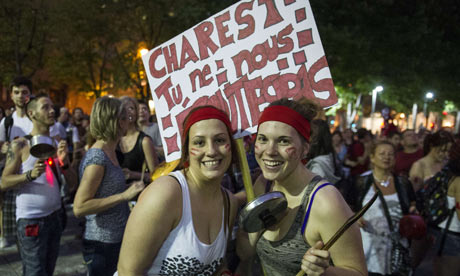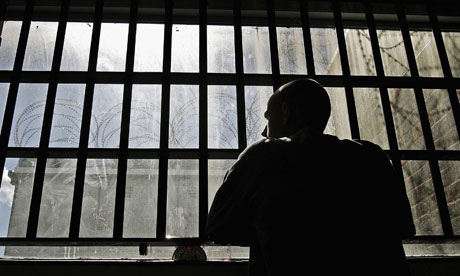http://www.details.com/culture-trends/critical-eye/201111/polyandry-plural-families
Modern Family
Plural relationships have gotten a bad name, thanks to lascivious cult leaders like Warren Jeffs. But there's a whole other type of multi-partner love gaining popularity: polyandry, in which a woman settles down with two or more men. And it's more common than you might think.
November 2011 Issue
On an unseasonably cool August Sunday
morning in Topanga Canyon, just north of Malibu, a family of four
arrives at the Inn of the Seventh Ray, an all-cage-free,
everything-local restaurant that's typical of the neighborhood. This
brunch is a welcome respite from the errands and worries that
increasingly fill their days. Jaiya Ma, the center of the clan, is a
34-year-old with dark, wavy hair and caramel skin. Her life is wide
open; she falls in love easily, suffers willingly. Next to her is Ian
Ferguson, a thin 44-year-old with a shaved head and a goatee, feeding
bits of eggs Benedict to their energetic 2-year-old son, Eamon. Ian and
Jaiya have been lovers for four years. Sitting across from Jaiya is Jon
Hanauer, an extremely fit 48-year-old wearing wire-rimmed glasses, who
serves as Eamon's primary caretaker. He and Jaiya have been in a
committed relationship for almost a decade.
Neither Jon nor Ian is legally married to Jaiya. Both are allowed to see other women. But the three of them live a lifestyle that—much of the time—isn't that different from a conventional marriage. They're one of an estimated 500,000 polyamorous families in the United States. Polyamory, which literally means "many loves," usually isn't about having sex with whomever you want, whenever you want, as nonpractitioners often assume. It can also describe relationship configurations like Jon, Jaiya, and Ian's—governed by rules, responsibilities, and expectations—which add up to a kind of de facto polygamy. The more specific term for their arrangement is polyandry, in which multiple men are with the same woman, a far less common arrangement (both today and throughout human history) than polygyny, in which multiple women are with the same man. Jaiya, who founded a successful sex-education company, is typical of the women in polyandrous triads: intelligent, self-possessed, professionally accomplished. The men, on the other hand, have typically suffered a relationship catastrophe that prompted them to seek radical change. Jon could be speaking for any of them when he recalls, "I knew in my heart that I had to find a different way to love."
It's not an easy lifestyle. "Think about all the challenges of any live-in relationship, squared, and you'll see the problem," says Janet Hardy, coauthor of The Ethical Slut (widely considered the bible of polyamory). By chance, the previous night at a bar in Venice, I met Holly (not her real name), a beautiful figure skater turned model Ian dated while Jaiya was pregnant with Eamon. Holly has a new guy, a handsome rocker named Danny. When I reveal this at brunch, Ian looks bummed; he still has feelings for Holly. But Holly's not a member of his and Jaiya and Jon's "species"—she's monogamous—and dating "out of species" is a problem for Jaiya. "It's one of the primary rules of polyamory," Ian explains, because a monogamous woman will almost always force a man to choose between her and his polyamorous life.
For his part, Jon has seen Jaiya get hurt too many times. "She jumps into things and I'm always cleaning up her messes," he says. "She understands that's one of the ways I express my love for her." Jon hasn't taken nearly as many lovers as Ian—all the dating and the play parties . . . that's not his bag. "You've got to manage yourself or you're going to hurt other people," he says.
Jon takes Eamon in his arms and walks to the restaurant gift shop, where they sit in a corner reading children's books. Jaiya and Ian sit in silence as the sun comes out and warms the patio. After we settle the check, they'll all head home. Ian will retreat to his office and work on design proposals, Jaiya will go to her study to work on the book on oral sex she's writing for Random House, and Jon will spend the day playing ball with Eamon.
•••
Plural love is having a moment right now. That's thanks in no small part to the increasing acceptance of gay marriage: If two men or two women can get married, why can't two men get married to one woman? In Canada, where same-sex marriage has been legal for six years, a case that's expected to go to the Supreme Court could make our neighbor to the north the first Western country that doesn't outlaw polygamy. Here in the U.S., Republican leaders like Mike Huckabee and Michelle Bachmann have made ominous suggestions that legalizing gay marriage will lead to group marriage. And the Mormon Church, not wanting to draw any undue attention to its past embrace of plural marriage, fought Proposition 8 three years ago, perhaps out of fear that practicing polygamists would demand that marriage equality be extended to them as well.
But it's hard to see the harm in egalitarian, secular arrangements like Jon, Jaiya, and Ian's. In 2001, the Law Commission of Canada issued a report questioning the illegality of consensual polygamy, and last year the Canadian Polyamory Advocacy Association asked the courts for a repeal of the ban on polygamy. In the U.S., too, legal scholars have challenged the merits of limiting marriages to two partners. Elizabeth F. Emens of the University of Chicago Law School questions why eliminating the "numerosity requirement" (one man and one woman) is considered undesirable when so many people are practicing non-monogamy, either secretly (through cheating) or serially (divorce, remarriage). And we certainly have polygamy on the collective brain—witness the popularity of TV shows like HBO's Big Love and TLC's Sister Wives.
But if plural marriage is ever to gain broad acceptance, it won't be
because of Mormon fundamentalists. It will be because of people like
Ian, Jon, and Jaiya—affluent, educated city dwellers in mutually
respectful relationships. And, indeed, some in plural relationships are
adopting an activist mind-set. "We're going through right now what
homosexuals went through 30 or 40 years ago," says Matt Bullen, a
42-year-old writer and married dad in Seattle who is part of a
polyamorist cluster that encompasses five people and two legal
marriages. "We need to start putting photos on the desk of ourselves and
our partners together. When I'm out in public with my wife and my
girlfriend, I need to say, 'These are my partners.'"
Matt's girlfriend, a 43-year-old filmmaker and actress named Terisa Greenan, goes further, expressing the virtues of her lifestyle in stark terms. "Polyamorous people are just smarter," she says. She dates Matt but has lived with Scott Campbell, a 54-year-old classical-music dealer, for 14 years, and Larry Golding, a 54-year-old Microsoft software developer (to whom she's married for insurance and accounting purposes), for 12 years. (Matt's wife, Vee, also dates Larry.) "You've got to have a certain type of brain that's really analytical," Terisa explains. "There are more people, so you have to be able to look at each problem from many more points of view and communicate for that many hours longer."
Whatever you think of Terisa's theory, it's obvious that those in plural relationships are comfortable flouting convention. Many explained to me that humans aren't hardwired to have just one partner. Mary, a 26-year-old Ph.D. candidate in economics at Boston University (who asked that her real name not be used), says she's known since she was 14 that monogamy was anathema to her. "That's when I realized that maybe it didn't make sense for me to suppress these feelings just because of a societal norm," she says. Hardly an insatiable minx, Mary claims she's "not a sexual person at all" and still lives—in a polyandrous triad—with her first boyfriend.
Ian went plural four years ago, after his six-year marriage fell apart, when he adopted a doctrine of "total authenticity. Anybody I was interested in, I told them right off, 'This is what I'm about.' Within four weeks, I was dating four women at the same time." He met Jaiya at an improvisational-dance class near his house, and they immediately fell for each other. Jaiya got pregnant and Ian moved in. "It was the first time I ever truly surrendered to a man," she recalls. It wasn't until after Eamon was born that Ian made the transition from a playing-the-field version of polyamory to something more like common-law polygamy. Ian would like to be dating more, but fatherhood and the demands of being the household's primary breadwinner have shown him that while "love is infinite, time is not."
Six years before she fell for Ian, Jaiya, who was engaged at the time, met Jon at a tantra class in Cincinnati. A couple of months later—two weeks before her wedding day—they reconnected and hit it off. Jaiya canceled the wedding when her fiancé couldn't handle the competition for her attentions, and she's embraced polyamory ever since. She now uses Jon as a sexual guinea pig in her Red Hot Touch instructional video series. "I tell people I'm an international penis model," he says ruefully.
Most who take part in plural relationships claim not to feel sexual jealousy. Dean, a 26-year-old software engineer in Boston, recalls being disturbed at the start of his relationship with Mary and her long-term boyfriend, Max (all three names have been changed), a 28-year-old intellectual-property lawyer, when he overheard them having sex in the next room. In time, he decided this was a selfish reaction. "Just realizing that there are times when she wants to have sex with one of us specifically makes things a lot easier," he explains. "Knowing that it balances out over time makes it easier too."
The trick, Matt Bullen explains, is being able to ask yourself, "'Why am I happy when my partner is satisfied in any other aspect of life, but then suddenly when it comes to sex it's got to be awful feelings of mistrust?' Can you isolate it so much that it becomes like a little trapped rodent in a cage where you can say, 'See, it wasn't that scary at all'?" He claims it doesn't upset him when his wife uses their marital bed to fuck her boyfriend (and Terisa's husband) Larry. "It's just a bed," he says. Some claim to derive pleasure from seeing their lovers getting screwed at play parties.
But however much they thumb their noses at jealousy, polyamorists can still fall prey to it. Scott recalls feeling stung the first time he heard Larry call Terisa "sweetie." Vee Bullen remembers being distraught when she heard Matt call Terisa "darling." The key, according to author Janet Hardy, is not giving in to your partner's jealousy. "You have to hear your partner be unhappy without feeling like it's your job to fix it," she explains. "Otherwise you're robbing your partner of the opportunity of learning how to survive jealousy."
Matt's girlfriend, a 43-year-old filmmaker and actress named Terisa Greenan, goes further, expressing the virtues of her lifestyle in stark terms. "Polyamorous people are just smarter," she says. She dates Matt but has lived with Scott Campbell, a 54-year-old classical-music dealer, for 14 years, and Larry Golding, a 54-year-old Microsoft software developer (to whom she's married for insurance and accounting purposes), for 12 years. (Matt's wife, Vee, also dates Larry.) "You've got to have a certain type of brain that's really analytical," Terisa explains. "There are more people, so you have to be able to look at each problem from many more points of view and communicate for that many hours longer."
Whatever you think of Terisa's theory, it's obvious that those in plural relationships are comfortable flouting convention. Many explained to me that humans aren't hardwired to have just one partner. Mary, a 26-year-old Ph.D. candidate in economics at Boston University (who asked that her real name not be used), says she's known since she was 14 that monogamy was anathema to her. "That's when I realized that maybe it didn't make sense for me to suppress these feelings just because of a societal norm," she says. Hardly an insatiable minx, Mary claims she's "not a sexual person at all" and still lives—in a polyandrous triad—with her first boyfriend.
Ian went plural four years ago, after his six-year marriage fell apart, when he adopted a doctrine of "total authenticity. Anybody I was interested in, I told them right off, 'This is what I'm about.' Within four weeks, I was dating four women at the same time." He met Jaiya at an improvisational-dance class near his house, and they immediately fell for each other. Jaiya got pregnant and Ian moved in. "It was the first time I ever truly surrendered to a man," she recalls. It wasn't until after Eamon was born that Ian made the transition from a playing-the-field version of polyamory to something more like common-law polygamy. Ian would like to be dating more, but fatherhood and the demands of being the household's primary breadwinner have shown him that while "love is infinite, time is not."
Six years before she fell for Ian, Jaiya, who was engaged at the time, met Jon at a tantra class in Cincinnati. A couple of months later—two weeks before her wedding day—they reconnected and hit it off. Jaiya canceled the wedding when her fiancé couldn't handle the competition for her attentions, and she's embraced polyamory ever since. She now uses Jon as a sexual guinea pig in her Red Hot Touch instructional video series. "I tell people I'm an international penis model," he says ruefully.
Most who take part in plural relationships claim not to feel sexual jealousy. Dean, a 26-year-old software engineer in Boston, recalls being disturbed at the start of his relationship with Mary and her long-term boyfriend, Max (all three names have been changed), a 28-year-old intellectual-property lawyer, when he overheard them having sex in the next room. In time, he decided this was a selfish reaction. "Just realizing that there are times when she wants to have sex with one of us specifically makes things a lot easier," he explains. "Knowing that it balances out over time makes it easier too."
The trick, Matt Bullen explains, is being able to ask yourself, "'Why am I happy when my partner is satisfied in any other aspect of life, but then suddenly when it comes to sex it's got to be awful feelings of mistrust?' Can you isolate it so much that it becomes like a little trapped rodent in a cage where you can say, 'See, it wasn't that scary at all'?" He claims it doesn't upset him when his wife uses their marital bed to fuck her boyfriend (and Terisa's husband) Larry. "It's just a bed," he says. Some claim to derive pleasure from seeing their lovers getting screwed at play parties.
But however much they thumb their noses at jealousy, polyamorists can still fall prey to it. Scott recalls feeling stung the first time he heard Larry call Terisa "sweetie." Vee Bullen remembers being distraught when she heard Matt call Terisa "darling." The key, according to author Janet Hardy, is not giving in to your partner's jealousy. "You have to hear your partner be unhappy without feeling like it's your job to fix it," she explains. "Otherwise you're robbing your partner of the opportunity of learning how to survive jealousy."
A potentially bigger problem for long-term polyamorous relationships is a declining libido. On nights when Ian ventures out for affairs with other women, Jaiya and Jon live an almost monastic existence. The three of them have little interaction with the Los Angeles polyamorous community, because, they say, meetings are dominated by old hippies with grown children and newcomers with questions about coping with jealousy. And Jaiya and Jon's relationship has turned effectively platonic since she gave birth to Eamon; where once, Jaiya claims, they had 20-hour marathon sessions, now they have sex only for her instructional videos and classes. Jaiya and Ian have tried to overcome the libido-killing effects of financial worries and child care with weekly date nights, out-of-town trips to hotels, and scheduled sex (Friday afternoons, after she tapes a show for VoiceAmerica radio). They are, Ian admits, like old married people.
That's hardly unusual. According to Thad, 31, and James, 43, both IT professionals and members of a long-term polyandrous triad in Bloomington, Indiana, with a writer named Mandy, 42, none of the three of them (whose names have been changed) date much outside of their relationship. "We've played with some other people," James says. "But nothing serious. All activity outside of the family has to be mutually approved. We have ground rules. No fluid exchange can take place." They also attend monthly family-counseling sessions.
Family counseling? Isn't plural love supposed to be the magic bullet to relieve the doldrums of monogamy? But Terisa reports a similar situation. "Our lives are so boring," she says. "I cook dinner. The guys clean up. We go upstairs and watch The Soup, and then we go to bed. Or the three of us go out to the movies. Or all five of us"—meaning the Bullens, too—"sit down to watch TV together. We do things as a family.
"The great thing is that the guys can go have sex with other people."
•••
Most men in polyandrous relationships get into them for one reason: They fall in love with the woman at the center of the triad. Few are looking for male companionship. Fewer still seek intimacy with their "metamour"—their lover's other lover. This isn't Big Love, and male polyandrists aren't sister husbands.
Although they've lived together for more than a decade, Scott describes his relationship with Larry as one of benign neglect. "We wouldn't be close friends in different circumstances," he says. "We're so different. We're perfectly cordial, but it's not common for the two of us to hang out and talk together if Terisa isn't there." Matt, Terisa's boyfriend, agrees. "I don't think I've ever been out for a drink by myself with Larry or Scott," he says. The relative distance among them, he adds, is why the arrangement works.
Max, the young lawyer, describes his relationship with Dean as being like that of stepbrothers. "We're family but not related," he says. Ian and Jon are like that too. They interact almost entirely through Jaiya and Eamon—"I get to love Ian through him," Jon says, pointing at the boy.
Nowhere was this truer than at Eamon's birth. The two men aided Jaiya in a natural, "orgasmic" labor in an outdoor hot tub that lasted 20 hours—with Jon sitting behind her at one point, massaging her anus and feeding her, and Ian in front massaging her nipples and clitoris, until at last Eamon passed into this world through one long climax while the Santa Anas blew and a pack of stallions whinnied nearby. Jon and Ian are two men who have shared one of the most intimate moments imaginable. They see each other every day. But at brunch, they speak in turn to Jaiya—never to each other. They rarely make eye contact.
•••
One Friday afternoon, Jon takes Eamon to Topanga State Park. He's scooping sand into a mound for the boy to run up and down on. "This is his athletic training," Jon says proudly. "I'd like for him to play baseball." Jon deserves much of the credit for Eamon's sunny disposition—the 2-year-old sings constantly and loves being read to. Ian matter-of-factly describes Jon as the "manny" and pays him a modest salary to look after Eamon. Jaiya says that Eamon occasionally calls Jon his "dada."
One of the great debates about plural love in America is about how it affects the children. In a September 2010 polemic in The American Spectator, William C. Duncan, director of the Marriage Law Foundation, argued that these kids might be at a higher risk of suffering abuse, behavioral problems, and household instability. But Dr. Elisabeth Sheff, a sociology professor at Georgia State University who has spent more than a decade studying kids from polyamorous homes, disagrees. "Many of the children in poly families are doing great," she says. "All the attention they get and the access to shared resources helps them blossom. Research on single parents shows us that it's too much work for one person. Polyamory comes at it from the complete other direction—that two people aren't enough." And polyandry gives a kid more father figures—perhaps not the worst family structure in a country where there's an epidemic of fatherlessness.
Matt Bullen is cautious about exposing his 9-year-old to the family's lifestyle. "It gives me nightmares that our family is from some awful seventies adult movie where my son comes down a swirling staircase and sees all kinds of shenanigans going on," he says. He and his wife, Vee, have sought to be "age-appropriately honest" with their son. When the boy saw his father kissing Terisa and asked about it, Matt explained to him, "There are ways of loving that you just can't understand yet." Some of the teachers at his school know about his parents' lifestyle, and he is reportedly happy, well adjusted, and obsessed with soccer. Having more adults in his life, Matt claims, has helped his son's development.
But Jon's demeanor sometimes seems to betray a current of bitterness. When Jaiya caught baby fever soon after turning 30, she begged Jon for a child. He refused, saying he wasn't ready for fatherhood, so she turned to Wyatt (not his real name), her brash young lover at the time. Jaiya miscarried; Wyatt walked out. Later, she and Jon discussed pregnancy again, and again he demurred. "I pushed her into having other relationships," he admits. But seeing Jaiya twice pregnant by other men has stung, and Jon's time with Eamon has made him realize that he desperately wants a child of his own. But after her miscarriage and her difficult pregnancy with Eamon, Jaiya doesn't want any more kids.
Jon has one option left—to go out and find someone else. It's not easy. He's had only two other lovers over the past six years. He doesn't do nightlife. He has no interest in play parties. "Those people are like teenagers who sleep around—they're just replaying teenage scenarios," he says. Jaiya encourages him to get out there. But if he did meet a woman? Is he prepared to pack up and leave? "I wouldn't want to go," Jon says. "I'd want to move that new person in with us. I'd want to expand our family, enhance what we already have at home."
He picks up Eamon, holds him tight, and walks toward the surf. Together, they enter the water, and Eamon cackles as they take on the breakers.





